August 2007 Cub Scout Roundtable Issue |
Volume 14, Issue
1
September 2007 Theme |
Theme:
Cub Scout Express
Webelos:
Citizen & Communicator
Tiger Cub Activities |
PACK AND DEN ACTIVITIES
Advancement Ideas:
www.cubroundtable.com
Tigers
– Ach 4D, 4F, 5G
Elect. 3, 4, 35, 48
Wolf
- Ach 1, 1B, 6, 9D
Elect. 2B, 5G, 11C, 12D, 16
Bear
– Ach 3F, 8E, 12B, 15B,
19A, 19C, 19D, 24A
Elect. 11
Alice, Golden
Empire Council
The Geography Belt Loop is a good
one to use with this theme, since railroads criss-cross the
entire country.
Tiger Cub Achievements:
Ach. #1G – go and see a railroad
museum or station.
Ach. #5G – take a hike – use an old railway that has been
turned into a bike or hiking trail, if possible. (Look online
for historic train trails, or ask local railroad or city
officials – some of these hikes also have special patches
available to earn)
Tiger Cub Electives:
Elect. #3-board game on pg. 6,
Program Helps (PH);
Elect. #17 – if you make a model of a train engine or
car;
Elect. #21 – if your den puts on a skit or puppet show
about railroads;
Elect. #33 – do a cleanup along a railtrail;
Elect. #41 – Visit a train station;
Elect. #48 – Go for a ride on public transportation;
Wolf Achievements:
Ach. #1b- Walk a railroad tie or
board;
Ach. 4f – If you visit a place connected with railroads;
Ach. #5d – if you practice “laying rail”;
Ach. #9d, e – If you learn about and practice safety
around railroad tracks;
Ach. #10c – If you plan a walk along an old railway path
Wolf Electives:
Elect. #2 – If your den puts on a
skit about railroads;
Elec. #4f – if you play one of the wide-area games from
this packet;
Elect. #5g,h,I – if you make a model of a train or train
car;
Elec. #6b – if you read a book about
trains;
Elec. #11c- learn a train song;
Elect. #12d – if you make scenery for a skit or for the
Pack Meeting;
Elec. #18d – if you help lay out an obstacle race about
the Transcontinental Railroad (see Pack & Den Ideas)
Bear Achievements:
Ach. #3 b, d – if you choose people
or places that have to do with railroads;
Ach. #4 - learn about the Casey Jones tall tale;
Ach. #6g – if you help clean up a railroad path that is
used for hiking or biking;
Ach. #8e – if you study the history of railroads in your
community;
Ach. #10a – if you go on a day trip on a train with your
family;
Ach. 14f,g – if you ride along a railroad bike path –
notice and obey the safety signals and warnings!
Ach. #15c – choose games from this packet;
Ach. #19 – earn the Whittling chip and carve a train
whistle
Ach. 24a – help a boy join Cub Scouts during Fall
recruiting
Bear Electives:
Elec. #4b – make a electric buzzer
question and answer game board about trains or the
Transcontinental Railroad;
Elec. #11 – Take pictures of trains that go through your
area or as you travel on a train. Photography was used to “sell”
the Transcontinental Railroad, with many photos of the West and
scenery seen from the train;
Ach. #23e – make a map showing a place you can visit by
rail.
Webelos Activity Pins:
Citizen and Communicator are assigned
for this month.
Other possible activities would be
Craftsman if you construct a shelf to hold a train or
other collections;
Engineer #7, using various types of railroad bridges,
Readyman #9, #14 – how to safely cross tracks;
Showman – if the den puts on a play or puppet show about
railroads or railroad safety;
Traveler – look up and plan a trip involving rail travel
FIELD TRIPS
Baloo’s Archives
Go on a train ride – either regular, light rail, scenic,
tourist. Many light rail (commuter) line run weekend specials
when traffic is light. Ride an Amtrak train a short distance
and return. There are historic steam train rides in many areas,
perhaps you can get a group discount. The Wilmington and
Western in Delaware runs out to a picnic grove. You can get off
and have a picnic and return later.
Visit a Train Museum with real cars and engines to climb on
and see. The Franklin Institute in Philadelphia has this.
So does the California State Train Museum I visited in
Sacramento. You can see the General, the train taken by the
Union during the Civil war in Kennesaw. GA, then go to the
Atlanta Cyclorama and see the Texas, the train the Confederacy
used to chase the General and stop Andrews Raiders. There are
several train museums near Lancaster, Pennsylvania
The following
sites have listings of many train museums:
http://www.railmuseums.com/
http://www.railsusa.com/links/Railroad_Museums/
Or simply
Google, railroad museums and your state
Visit a model railroad display or club for an exhibition.
These sites
list model railroad clubs you can contact
http://www.railsusa.com/links/Model_Railroad_Clubs/
http://www.t-one.net/~om/train.htm
Or simply
Google, model railroad displays
Visit a local train station. Many train stations have
been restored and are used to attract visitors and tell the
story of railroading. The Amtrak Station in Wilmington,
Delaware has an historical designation. I am sure touring Grand
Central or Penn Station in NYC would be a real eye opener.
Watch Fess Parker in “The Great Locomotive Chase.”
Maybe not, but I would really enjoy it. My wife knows she will
lose me for a weekend if Disney ever does a Fess Parker Marathon
(Davy Crockett, Light in the Forest, Old Yeller, …) CD
J
J But in a
serious note there are many train movies – some regular
commercial films, some videos of the dramatic scenery along the
rails, some histories of steam.
Pack and Den Activities:
Alice, Golden Empire Council
ü
Visit a local railroad station. Call ahead and
ask if you can have a tour – many of the old stations are
wonderful, huge and with beautiful murals – even those that are
no longer used as stations are sometimes open as historical
structures and used for public events. Check the website
listings or ask your local Chamber of Commerce or reference
librarian.
ü
Take a short trip on a real train - ask about
excursion or group rates. Ask about docents or tour guides, and
see if brochures, paper engineer hats, paper train models are
available.
ü
Let the boys help plan a trip by rail, light rail
or even bus. (Look under the Webelos Communicator section
for ideas on how to use schedules and online planning – Alice)
ü
Have a Den put on a skit about the Driving of the
Golden Spike – for an authentic account with a script adapted
for 4th-6th grade students, Either get he
skit from the Skit section of Baloo or go to
http://www.nps.gov/gosp/research/script4_6.html.htm You can
use the script as is or study the story with the boys and let
them make up their own skit. The funny incidents in the script
really happened!
ü
Visit a local model railroad exhibit as a den or
pack.- check website for nearby exhibits.
ü
Visit a local railroad museum – check the website
for locations.
ü
Have each den (or family) make a Train cake – give
each den a small loaf-pan size cake and let them decorate their
train car with cookies, frosting, candies, licorice. You can
either assign the type of car or let them choose. When the cars
arrive, the cars could be connected with licorice ropes. For a
good example of how various cars look, provide pictures from
http://www.ribbonrail.com/arat/index.html
ü
Invite a local model train collector to come and
show some of his collection and talk about railroads.- check the
website for a list of clubs and collectors in your area.
ü
Contact a railway that does business in your area
– ask a representative to come and talk about safety around and
on trains, what kinds of products trains carry in your area, how
trains help supply stores and manufacturers, automobile dealers,
etc. in your area.
ü
Help the Webelos Dens sponsor a RR Safety meeting
at a local school, chartered organization or community center.
Check under Webelos Citizen for ideas.
SERVICE PROJECTS
Heart of America Council
Hold a clean
up day at sponsoring organization.
Rake leaves
for an elderly citizen.
HIKES
Heart of America Council
Safety Hike: Hike around the school or park identifying
safety areas for the children.
Season Hike: While hiking identify what is changing to
fall in the outdoors.
While you absolutely CANNOT
(No Ifs, Ands, or Buts) hike along active (still in use)
railroad tracks the Rails to Trails Conservancy has established
hiking and biking trails along abandoned railroad right of ways.
Hike Along an approved Rail Trail. Go to the Rails to
Trail Conservancy Web Site
http://www.railtrails.org/index.html
And find
trails in your area. They have a directory set up by state and
most states have several subsections to help narrow your
search. Also, learn about the great work they are doing in
creating these recreational areas. The list tells you what is
allowed on the trail – hiking, biking, skating (in-line and
roller), skateboarding, Horseback Riding, Wheelchair
Accessible,… An approved rail trail is easy to identify –
there are NO TRACKS in the right of way. If you are hiking near
tracks – you are being unsafe – leave that area!!!
Ideas for Pack Activities:
Baltimore Area Council
ü
Have a Pack ceremony to welcome your new Scouts
ü
Induct new leaders
ü
Hold a Pack Grandparent’s Night
ü
Visit a Trolley Car Museum
ü
Visit a model train group or outdoor train garden
ü
Visit a cornfield maze
ü
Visit the B&O Railroad Museum in Ellicott City
Train Car Activity
Heart of America Council
Materials –
Large Cardboard boxes, paint, string, glue, wide ribbon (or
rope), box cutters, paper plates, markers, construction paper,
buttons and any other decorations.
Directions:
ü
Use one large cardboard box per child.
ü
Cut top and bottom off.
ü
Make shoulder straps from heavy ribbon or string.
ü
Have each Cub paint or decorate his own train car.
ü
Use small painted paper plates for the wheels.
ü
Give each family about 20 minutes to decorate
their boxes (this can be done at a den meeting) and then bring
them to the Pack Meeting.
ü
At the Pack Meeting, the Den Leader becomes the
“conductor” for his or her den.
ü
Each den then “hooks” up and then proceeds to
parade around the track singing “I’ve been working on the
Railroad” several times.
ü
The “judge” then gives out awards for the best
looking, best decorated, best design, etc. and certificates to
the dens.
Make a Railroaders Cap
Alice, Golden Empire Council
Let everyone
make a conductor’s hat or engineer’s hat as they come in.
Painter’s caps are usually available for free from paint stores
or home improvement stores – just add stripes for an engineer’s
cap. To make a conductor’s cap, take a piece of dark blue or
black poster board and cut a strip about 4” wide and long enough
to overlap when placed on the head. Staple the hat where it
overlaps. Now make a flat brim shape with a rounded edge and a
straight edge about 4-6 inches wide (wide enough to go start at
one edge of the face and go to the other edge – You can use
either poster board or construction paper. On the straight edge
of the brim, leave an extra inch – this can be cut about every
½” so that you can fold it up and either glue or staple to the
inside front of the conductor’s cap. Add Gold or silver logos
and number – check out the ribbonrail historical website (
www.rrhistorical.com ) for actual photos of insignia
– you could even download one and glue it to the front of the
cap.
Tricky Train Tracks
Utah National Parks Council
You will need one skein of yarn for each
family. This will take some time to set up, so plan to be at
the pack meeting site early. Start with one end of each skein
taped to a stationary object near where the cubs and their
families will enter. Take each skein of yarn individually and
string it around the room or outdoor location, ending at a
picture or word strip with the name of a place you could travel
to on a train. Start with another family’s skein of yarn,
winding yarn over, under and around objects and other yarn
skeins – you will end up with a maze. Make sure you have a
different destination for each skein of yarn. Have a list of
the destinations posted at the entry area. Before beginning,
each family signs in and guesses which will be their
destination. To play the game, each family starts with the end
of their skein of yarn, winding it up in a ball as they go
through the maze. Families who guess the correct destination
win a package of string licorice.
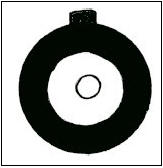
Locomotive Neckerchief Slide
Heart of America Council
Materials:
1/2” thick section of a 1 1/4” diameter dowel;
1/4” thick section of a 7/8” diameter dowel;
Pony beads (1 black, 1 clear);
Paint (black, silver);
1” long piece of 1/2” diameter PVC pipe;
Hot glue and gun
Directions:
1.
Sand dowel sections.
2.
Paint larger dowel black and smaller one silver.
3.
Let dry.
4.
Glue small dowel to the center of the larger dowel.
5.
Glue clear bead to the center of the small dowel
(headlight on front of the engine).
6.
Glue black bead to top of slide.
7.
Glue a section of PVC pipe to the back of the slide.
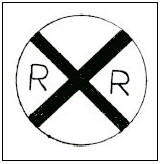
Railroad Crossing Neckerchief Slide #1
Heart of America Council
Materials:
A metal juice can lid;
Scrap paper (yellow, black);
Black marker;
1” long piece of 1/2” PVC pipe;
Glue (Tacky glue best. Hot Glue doesn’t work well on metal)
Directions:
1.
Trace the lid on yellow paper. Cut out the circle.
Glue the circle on the lid.
Optionally, if you have paint that sticks to metal, paint the
lid yellow.
2.
Cut two strips of black paper.
3.
Glue on the yellow circle.
4.
Write ‘R’s as shown.
5.
Glue a section of PVC pipe on the back.
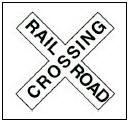
Railroad Crossing Neckerchief Slide #2
Heart of America Council
Materials:
Two large craft sticks (tongue depressors);
White acrylic paint;
Black permanent marker;
Glue;
1” long piece of 1/2” diameter PVC pipe
Directions:
1.
Cut the craft sticks to about 3” long.
2.
Glue them like an X.
3.
Paint the X white.
4.
Let dry.
5.
With the permanent marker, write “RAILROAD” and
“CROSSING” as shown.
6.
Attach a section of PVC pipe on the back.
Train Engine Tie Slide
Heart of America Council
ü
Use rectangle piece of wood to make a 1” x 3”
floor of engine.
ü
Glue on a 1” square block for cabin.
ü
Glue 2” long dowel for front of engine.
ü
Screw in small wood screw with large head for
smoke stack.
ü
Glue two wheels to front side of slide.
ü
Make larger wheel on the back. These can be caps
from medicine bottles, buttons or cut from milk carton.
ü
Glue a piece of PVC pipe to back.
ü
Paint entire engine black.

Scrap Wood Train
Heart of America Council
Materials:
Assemble some
scraps of wood and a broomstick section (or some spools) to make
a toy train.
Use a long
board for the base of each car.
Directions:
ü
For the engine, shape the base board to a point.
Use sections of a broomstick and a block.
ü
Tank cars may be fashioned from sections of a
broomstick and various size dowels.
ü
Use blocks of wood for the refrigerator car,
caboose, etc.
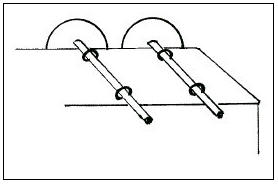
ü
You can make movable wheels from small sections of
a broomstick, 1/4” dowel axles and screw eyes.
Drill a 1/4” hole in the middle of each wheel.
Glue a dowel piece into one wheel.
Place the dowel through two screw eyes attached on the bottom of
the train (see illustration).
Glue the other wheel onto the axle.
ü
If you are making a train for a decoration, simply
fasten the wheels to the base with nails.
ü
It’s easier if you paint parts before attaching
the wheels.
ü
To link the cars together, add couplings made from
paper clips or cup hooks.
Thomas the Tank Engine
Baltimore Area Council
Materials: Fun foam, construction paper or another
heavier paper scissors, glue, crayons,, color pencils,, or
markers
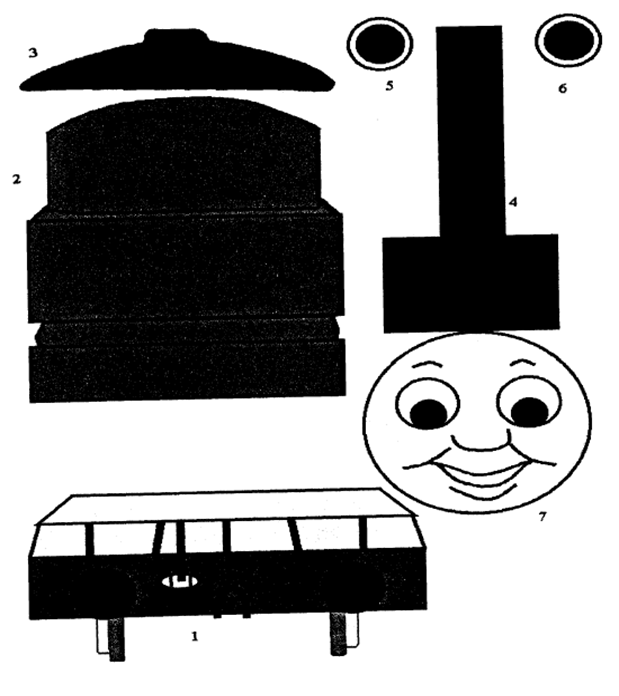
Enlarge pattern to desired size.
Then, trace or make copies of the pattern
Color pieces
as necessary,
#l is red on the bottom and
grey on top,
#2 is blue,
#3 and #4 are black,
#5 and #6 are black on the
inside, yellow on the rim
#’7 is grey.
Cut out the pieces. This step may require adult assistance and
can be done prior to craft time (if you’re coloring the cut out
pieces, put a roll of masking tape on the back and tape lightly
to newspaper or scrap paper).
Glue the
pieces together. It’s a good idea to pre-do one for a sample
before doing these crafts with a bunch of young kids, so they
can see what it looks like finished.
ü
Glue #2 (the “body”) on top of #l (the
base/wheels)
ü
Glue #3 on top of #2
ü
Glue #4 under #2
ü
Glue #5 and #6 on either side of #3
ü
Glue #7 (“head”) on top of the whole thing
Strawberry Basket Trains
Heart of America Council
Save your
strawberry baskets to make a fun train.
Simply connect
the baskets (open sides up) with twisty ties. Use construction
paper to make wheels, a locomotive cab, decorations for the
cars, etc. and glue onto the basket.
Tie a string
to the front of the train to pull it around.
Fill your cars
with treats, Scout stuff, etc.
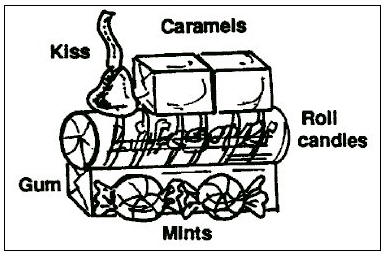
Candy Engine
Baltimore Area Council
Materials:
Low temp hot glue gun,
Ribbon or yam for hanging,
1 roll of Lifesavers (cylinder about 3½ inches long),
1 small package of gum (3” x ¾” x 3/8”),
4 round wrapped candies (such as peppermint Starlight mints),
1 Hershey’s Kiss,
1 large rectangular caramel-like candy (Tri-colored candies
called “Sundaes” made by Braches work great. You can use
multiple Starbursts or caramels glued together to make a
rectangle that measures about 1” x 1” x ¾”),
1 mini chocolate bar ( 1½” x 1” x 3/8” such as Hershey’s Mini
Bars)
Directions:
ü
Keep all candies in wrappers.
ü
Use a drop of tacky glue or low temp hot glue to
attach each piece as shown.
ü
Glue the Lifesavers roll to the gum package,
letting the Lifesaver roll hang over at both ends.
ü
Fold the extra cellophane around to the back of
the round-wrapped candies and glue it down.
ü
Let dry.
ü
Then glue the round- wrapped candies to the lower
sides for wheels.
ü
Push the rectangular candy onto the Lifesaver body
to make the cab of the engine. Glue on.
ü
Cut the paper off the top of the Hershey’s Kiss
and flatten the point a bit by pushing it against the table.
ü
Put a good-sized glob of hot glue on the tip, and
then glue it to the top of the Lifesaver roll.
ü
Glue the mini chocolate bar on top of the cab for
the roof.
Be
creative!
You can substitute a rectangular candy package (such as Jolly
Rancher) for the Lifesavers.
Or, you can glue a set of Starburst candies together.
Instead of the Hershey Kiss smokestack, try one or two wrapped
Rollo candies.
Glue the top (smaller side) to the roll of Lifesavers. Glue
another Rollo (larger side) on top of that if desired. Go to
your local store and look for rectangles, circles, shiny
wrappings, etc. in the candy department.
Find something that will work for you-
These instructions are just to get you started.
If you want to make cars for the train, simply use rectangular
candies in various combinations with four round candy wheels.
You could even put some Gummy bear passengers in some of your
cars.
Topographical Maps
Alice, Golden Empire Council
Use this theme
to teach the boys a little about topographic maps. If you don’t
have one, you can download them from the internet.
If you use a
map from around the Donner Lake area (California and Nevada) ,
they will be able to see the elevation changes that the Central
Pacific had to deal with.
Also, tracks
could not be laid out with sharp turns, or they would have too
many accidents.
You can also
look for other features that would cause problems, such as
rivers, lakes, mountains and gullies.
Trains From The Future
Heart of America Council
We can look in
books to see pictures of trains from the past, and look on the
tracks to see trains of today. But what will trains look like in
the future?
·
Provide a large assortment of crafting materials
(such as cardboard tubes, cardboard, craft foam, construction
paper, pipe cleaners, juice cans, empty containers in different
sizes and shapes, etc.) and glue and scissors.
·
Let the boys use their imaginations to create a
train of the future.
·
Give it a name and describe some of its special
features.
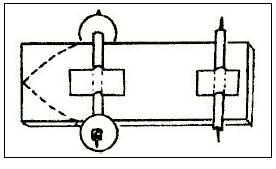
Animal Cracker Circus Train
Heart of America Council
Use this box to keep wrapped candy or small toys.
Materials:
Animal cracker box;
A drinking straw;
Scrap cardboard;
Two round toothpicks;
Tape.
Directions:
1.
Cut off the lid and top flaps at the folding line.
2.
Draw four circles about 1 1/4” diameter out of scrap
cardboard.
3.
Make a small hole in the center of each wheel.
4.
Cut the 2 pieces of straw about 1 1/2” long.
5.
Tape the straw pieces to the bottom of the box.
6.
Put a toothpick through the straw. Attach wheels.
A View From A Train
Heart of America Council
Take a train ride without leaving the comfort of your den
meeting. Make a scene that you could see from a train window. It
can be as silly or serious as you would like. Use your
imagination and creativity to see what kind of train ride you
can design.
Materials:
White poster
board (14” x 22” minimum);
Colored
pencils, markers, crayons;
Large piece of
corrugated box cardboard (20” x 28” minimum);
Utility knife;
Masking tape; Pencil; ruler.
Directions:
1.
Using a pencil, start sketching a view outside the
train window directly onto the poster board.
2.
Color it with colored pencils, markers, or crayons.
To make the
window frame,
3.
Measure a 20” x 28” rectangle on the corrugated
cardboard.
4.
Cut it out carefully with the utility knife.
(ADULT ASSISTANCE NECESSARY)
5.
Center the poster board scene exactly in the middle
of the cardboard rectangle.
6.
Trace the outline of the poster board onto the
cardboard. Remove the poster board.
7.
Draw a second outline 1/4” inside the outline on the
corrugated cardboard. To do this easily, make a dot 1/4” inside
each corner, then connect the dots with a ruler.
8.
Cut along the inside lines with the utility knife.
(ADULT ASSISTANCE NECESSARY)
9.
Decorate the front of the frame if desired.
10.
Place the window frame on top of the drawing so that
the drawing is “framed.”
11.
When it is positioned right, flip both boards over
and tape your drawing securely to the back of the frame.
12.
Display at the pack meeting.
VARIATION: Make the drawing and frames half the size
specified, and make several different windows that can be strung
together to make an expanded train scene. This can be called “A
Den’s Train Trip.”
Make A Recycled Train!!
Heart of America Council
Materials:
Cereal boxes and other small boxes like Jell-O boxes
One. gallon milk or juice cartons
Oatmeal round boxes
Old thread spools
Small paper plates (dessert size)
Frozen juice can lids
Cotton balls or polyester stuffing
Construction paper
Glue, Tape, Markers
Buttons, Twine or yarn, Scissors
Straws, Tongue depressors or craft sticks
Directions:
·
If you have enough stuff, each boy can make his
own train or get a large piece of cardboard and have each boy
make a ‘car’ for the train.
·
Lay out the “track” with tongue depressors/craft
sticks and straws.
·
The Oatmeal round boxes make wonderful “engines”.
·
Use the used thread spools as the smoke stacks,
with a small box for the engineer’s cab with the wheels made of
juice can lids or paper plates.
·
Have the boys use construction paper to cover the
boxes and make the front apron.
·
Then use the yarn or twine for the bars on the
wheels. Gluing some polyester stuffing or stretched cotton balls
on top of the thread spool gives the look like a working steam
engine.
Pinewood Derby – Train Style
Alice, Golden Empire Council
Use the blocks made for pinewood derby cars
to make railroad cars instead. Assign each boy or family to
make a certain kind of car, using the block as the basis. In a
large pack, with several dens, each den or den families could
form one train. In a smaller pack, you might have just one
train, with each boy or family making a car. Be sure and furnish
them with information about where they can find a picture of
their type of car. See the website list for ideas. There should
only be one caboose (a car that really isn’t used anymore,
except on historical railroads) and possibly only one engine,
although some freight trains are pulled by more than one engine.
Make sure that each car has one end left free, so that a hook
can be added to form a train. At the pack meeting, den trains
can race against each other, or families can race one another or
partner with another family to form a longer train. Have
someone ready to do a weigh-in and add weight if needed. You
may want to change the rules as far as weight, since most cars
will use the whole block of wood. Once there has been a race,
let everyone mix it up and race various trains.
Materials found in Baloo's Bugle may be used by Scouters for Scouting activities provided that Baloo's Bugle and the original contributors are cited as the source of the material. |
|





